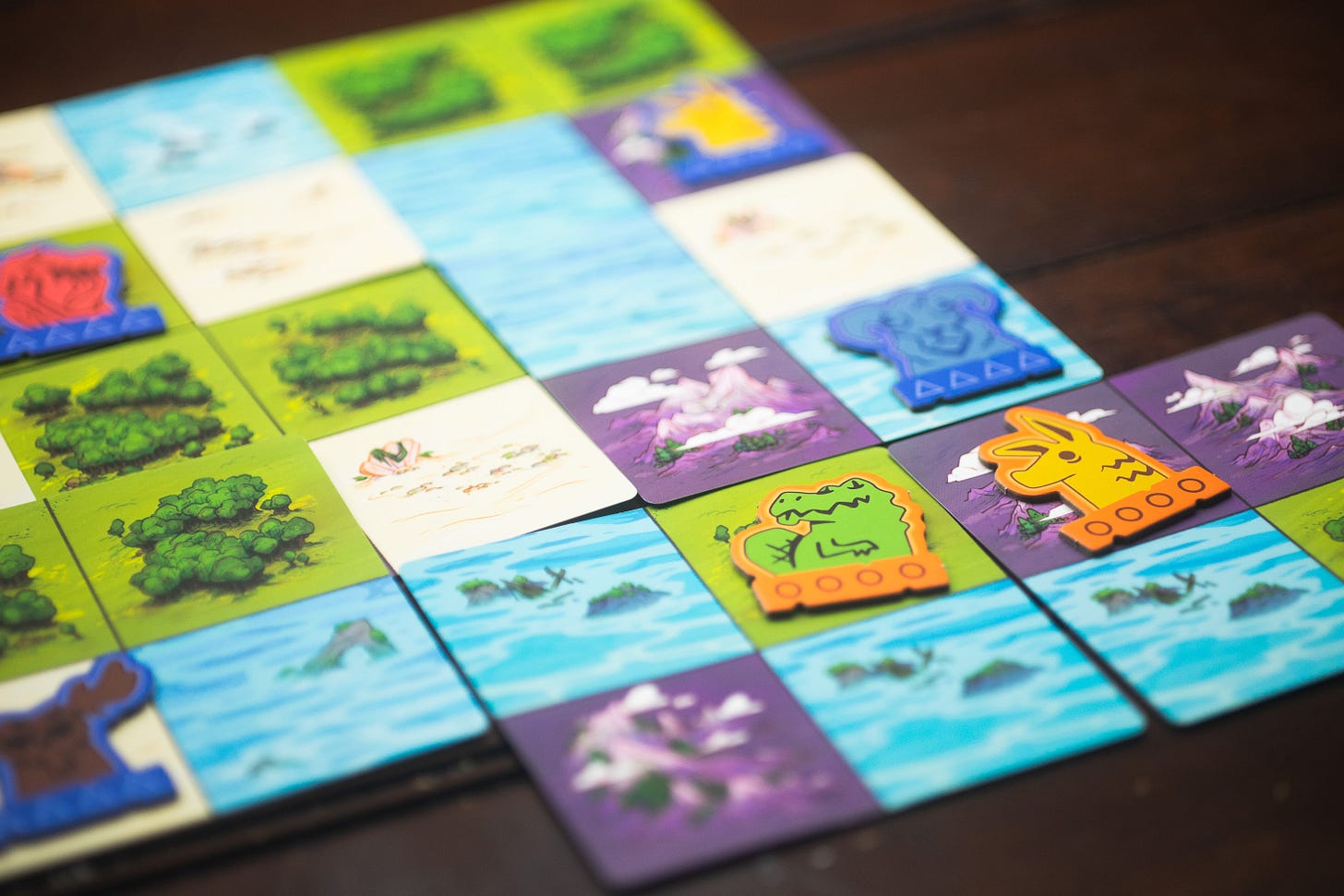Two great games to play this summer: Oddland and Hot Streak
These two games offer two sides of the family-weight coin.
Summer marches forward, and as usual, it’s a bit early in this neck of the woods. The temperatures are ramping up, and so is the outdoor time — but with that come opportunities for games afterward, and as I noted last week, I’m particularly interested in games for my toddler (which still feels wild to say!). The last week has seen him ask to play board games at a near-constant rate, especially Here Fishy, Fishy! (Mückel, 2022) and Animal Upon Animal (Miltenberger, 2005). Of course, I’m not going to dive in deep on these games, but I thought a follow-up was worth a mention.
I thought this week I’d talk about some of the great family-friendly games I’ve played recently. This week’s a little bit of a grab bag, which is often what happens when I wrap up a larger project, like last week’s look at Reiner Knizia’s designs. Perhaps a better-prepared writer would space these out, but I sort of fly by the seat of my pants week-to-week, and this is just what you’re going to get with me.
There have been a few games recently that have showed up at my doorstep (as a result of my having ordered them, that is.) An Allplay order just arrived with several games, including the trick-taker Ruins (Clair, 2025) with its transparent cards, a reimplemented Knizia game in Money! (Knizia, 1999), the bluffing game Vegas Strip (Hayward, 2025) and Oddland (Schumacher, 2025), which is where I’ll start my newsletter today.
I don’t like describing games in strictly comparative terms. It’s reductive, and it often isn’t accurate. It’s with that caution that I’ll say this about Oddland: It reminds me a lot of Kingdomino (Cathala, 2016), and it also reminds me a lot of Cascadia (Flynn, 2021). It doesn’t feel like the games jammed together, and it doesn’t feel derivative. We’ll start first by talking about Oddland, then we’ll move to how these other two games fit into the mix.
Oddland is a tile placement game where each tile (in this case, a large square card) is divided into four squares, and each square is one of four terrain types. You’ll be constructing a shared map, and you’ll be placing animal tokens on that map. These animals you’ll be placing consist of five different chimeric species: begator (the body of a beaver and the head of an alligator), pigeorses (with the body of a horse and the head of a pigeon), the big-horned grizzleep (body of a bear, head of a sheep), the owloose (the body and head of an owl, and the antlers of a moose), and the pangeroo (the torso and head of a pangolin, and the lower body and tail of a kangaroo.) None of that’s particularly important to gameplay, mind, but there’s something fun particularly about a game that plays within a universe and commits to it. More importantly, each animal features two unique scoring conditions, one of which will be used each game, and that’s the game’s core conceit. You only have one token for each animal, so your opportunities for scoring are very limited. It also forms the game’s timer — it’s only going to last six or seven rounds, depending on the number of players at the table.
None of the scoring mechanisms are particularly complicated. You might score one species for neighboring territories (one or more contiguous tiles of the same terrain), the surrounding animal species, or some other constraint. Those constraints escalate the game from a quick, simple excursion to one that requires a bit of forethought. While it’s fundamentally tactical — you’re only holding two map cards in your hand at any given time, so your decision space is limited — there’s just enough of an idea of strategy that your early decisions do matter. In a game that lasts at most seven rounds, that becomes particularly important.
Allplay, who have planted their flag on approachable games with reasonable depth, has produced a number of games that feel about as strategically complex as this one. Oddland fits neatly, but it also feels like a really worthy entry into the lightweight abstract game category. Perhaps my only complaint is that the names of the animals are particularly hard to remember, particularly because they’re not established in the chimera canon. (Maybe they couldn’t get the rights to the legendary esquilax, a horse with the head of a rabbit and the body of a rabbit.) I’ve found it difficult to remember both scoring conditions and the fun names, so each turn I take starts with me looking over the scoring cards.
I’ve described this game above as a bit like Kingdomino-meets-Cascadia, and hopefully that’s become clear here. It’s definitely a step up from the complexity of Kingdomino, where there’s one consistent scoring condition based on your own little fiefdom. Cascadia exists on the other side of the complexity scale (relative to Oddland, I mean — it’s not a particularly complex game), with the bulk of the complexity coming from where you place the animals you draft, as well as in the draft itself. Both of those games hold up incredibly well to scrutiny. I’ve played Oddland several times now, but it’s far too early to say if it holds up the same way. Will it be a real issue that there’s no player-held card for the variable scoring opportunities? It might be, but I think it’s a solvable problem in later editions, and it’s not an insurmountable concern for new players. But for a game that feels pretty smooth and considered, that little hitch can just be a little much.
Still, if that’s my only real concern, I think the game’s in a good position to succeed. It’s one of Allplay’s stronger lightweight offerings, and I’ve thought several times since about the art, theme and gameplay. It’s a good sign, at least. Designed by Dan Schumacher, illustrated by Cam Kendell, and published by Allplay in 2025.
The other family-weight game I wanted to discuss today is Hot Streak (Perry, 2025), a wild little horse-betting game of sorts, except you’re not betting on the ponies, you’re betting on misfit mascots running a race. The mascots, as you might expect if you’ve been to a professional sporting event, are goofy and unpredictable. You never know if they’re going to run in the right direction, if they’ll veer off course, or if they’ll run into each other.
The whole game is centered around placing bets on these racers. It’s a well-established idea, and Hot Streak does something interesting with it. Most race-betting games I’ve played involve placing bets throughout the race, reacting in real-time to the events unfolding. Camel Up (Bogen, 2014) is perhaps the best-known, with a game that moves along at a reasonable pace, with players having time to bet on racing camels. It’s somewhat of a classic after more than a decade, with the 2018 second edition giving the game new life even today. Ready Set Bet (Clair, 2022) pushes up the chaos slider with a real-time game that moves extremely quickly when it’s at its best. It’s tremendously fun, especially when you’re playing with somebody calling the race and rolling the dice. Long Shot: The Dice Game (Handy, 2022) and Winner’s Circle (Knizia, 2001) both are well-regarded in the horse-racing genre, too, though I haven’t played either. The former is very much on my to-play list, and the latter is another example of a Reiner Knizia reimplementation of his own 1995 Turf Horse Racing.
Hot Streak is fast-paced, but you’re not doing any of your betting while the race is running. You’ll draft your bets at the beginning of each round, choosing between main bets and side bets. Your main bets are the classic finishing position bets, and they’re nice ways to earn a lot of money, but they decrease in value, so if you’re not drafting early, you might balk at the decreasing outcomes. Your side bets always have the same potential value, but they’re outcomes that may or may not happen in the game at all, and you’re betting whether it happens at all. Your bets will vary pretty widely, ranging from a mascot veering off the track and being eliminated as a result, a mascot finishing last, or a mascot trampling over another mascot.
All that’s fine and good, but it doesn’t provide any way of understanding your bets when you place them, and that’s where the game shines the brightest. Most racing games have randomly decided outcomes, and you’re essentially betting on probability as you go. That’s fine and good for other games, but it’s not good enough for Hot Streak. In this game, the racers move on the track based on cards drawn from a deck, and that deck is made of four starting cards (one per mascot) and a selection of cards randomly picked from the full deck according to the number of players. No two games will be exactly the same, and you get to see that entire set of cards at the beginning. And that’s great, too, but it’s not enough for Hot Streak. That much information is nice, but every player has an equal understanding. No, like any great mascot, Hot Streak necessitates a certain amount of deceit.
Each player is also dealt three cards from the deck, and after drafting each round, each player picks one card from their hand to add to the shuffled deck. Those three cards hold the secret to what makes Hot Streak great. It’s enough to influence your bet, obfuscate your planning, and throw other players off. It adds essential uncertainty to the game. Rather than betting in-race, you’re betting at the beginning, but you know something nobody else knows. Because you draft bets around the table before you add your card, you can see how other players have bet and add in a card to make life difficult for the opposition. Maybe everyone thinks Dangle’s absolutely going to win the race because of the cards present, but you don’t have a good bet on Dangle — maybe you’ll throw in a card to make him fall down or turn around. Maybe you’ll instead boost another mascot further, unbeknownst to the other players.
Hot Streak is wild fun. There’s tension and laughter while you’re flipping over cards, even though you can’t take a single action during that time. The race progresses, and there’s not a sense of routine about any of it. Anything can happen, and you’re rooting for your bets to play out and others to fail. The game’s exciting, and that’s quite an accomplishment.
Designed by Jon Perry, illustrated by Cécile Gariépy, and published by CMYK in 2025.
Well, that brings us to a close this week. I’ve really enjoyed these two games, and as the summer kicks off, I suspect more people will be getting together with friends and family. These are great options — one’s a bit thinky, one’s a bit wild, but both are approachable for new players, and both have a teach that’s not unmanageable.
I hope the week’s found you well, and I hope the upcoming week finds you well, too. Thanks for reading!






